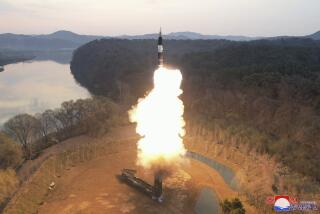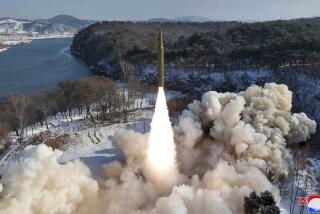Secret Northrop Missile Racks Up Sky-High Losses : Aerospace: The stealth TSSAM, under development in Hawthorne, is expected to be one of the most expensive in the U.S. non-nuclear inventory.
- Share via
Northrop Corp. is developing a secret missile that is supposed to be invisible to enemy radar, but the weapon’s bloated cost has become an all-too-familiar sight on the company’s balance sheet.
Intended to be one of the Pentagon’s most advanced weapons, the missile is the tri-service standoff attack missile, known as TSSAM. (Tri-service refers to its ability to be launched by Air Force and Navy aircraft, and by Army units on the ground.)
The TSSAM is expected to be one of the most expensive non-nuclear missiles in the U.S. arsenal. The Air Force estimates that the total cost of each Air Force TSSAM will be $2.1 million, with each Navy version to cost $5.2 million.
TSSAM remains a military secret, and no photograph or sketch of the stealth missile has ever been made public. Under development since the mid-1980s, its existence was acknowledged only three years ago, when the Pentagon disclosed that the missile was being developed at a Northrop plant in Hawthorne.
Since then, however, TSSAM’s costs have become glaringly obvious. Northrop recently said its profits last year fell 21%, to $96 million, because of a TSSAM-related loss of $201 million. Earnings in 1992 included a similar loss of $152 million.
Los Angeles-based Northrop, which also builds the B-2 stealth bomber, has lost more than $600 million on the project since it was launched. “We did not anticipate the degree of complexity that’s involved,” admitted James G. Roche, Northrop’s head of advanced development and planning.
The losses are likely to continue--though not at their present pace--until 1997 when the missile will finally be ready for production. The program’s director, Air Force Brig. Gen. Richard Roellig, has estimated that Northrop’s total losses could eventually reach $750 million, while some two dozen subcontractors could lose another $250 million.
Northrop is developing the missile under a fixed-price contract, meaning it has agreed to receive a fixed amount of money from the Pentagon for design and testing. Northrop has to absorb any costs above the contract amount.
The Pentagon valued the entire project at $15.1 billion in 1991, but did not break out the price of Northrop’s research-and-development portion. TSSAM is the last of Northrop’s fixed-price contracts.
Fixed-price contracts were embraced by the Pentagon in the mid-1980s as a way to curb procurement fraud and general military spending. But they later fell into disfavor after contractors sustained major losses developing sophisticated hardware whose costs soared above initial estimates.
McDonnell Douglas Corp. and General Dynamics Corp., for instance, are in court trying to recoup $1.5 billion from the Pentagon for developing the now-canceled A-12 Navy attack jet under a fixed-price contract. McDonnell’s trouble-plagued C-17 military cargo jet is more than $1 billion over its budget, and Hughes Aircraft Co. lost more than $250 million developing the advanced medium range air-to-air missile (AMRAAM).
As for TSSAM, Northrop is confident it can overcome the missile’s technical obstacles, Roche said. “It’s just that we’re not able to build the missile under a fixed-price contract at the price that was specified.”
*
Although the TSSAM is classified, Northrop has said the weapon would be a cruise missile, meaning that it would use its own engine to fly to its target. The missile would have a range of more than 100 miles, and could attack enemy airfields, ships and air-defense and command-and-control sites.
The Army recently bowed out as a customer, cutting the number of missiles to be bought by the Pentagon by nearly one-third and making the “tri” portion of the program’s name obsolete. But Roche said Northrop still hopes to garner $10 billion or more in sales from producing the TSSAM into the next century.
While no formal production contract has been signed yet, the Pentagon now plans to have one contractor build all the missiles, instead of two as originally planned, Roche said. Northrop obviously expects to be the TSSAM’s sole source. Pentagon officials could not be reached for comment.
Although the Army is no longer involved, the Air Force and Navy have told Northrop that they’re still committed to the weapon, Roche said. But any further snags in the TSSAM’s development could jeopardize the missile’s standing in Congress.
Last fall, the House Appropriations Committee urged that TSSAM be canceled, based on a General Accounting Office report that outlined the missile’s woes. “This program has a history of development problems, cost growth and schedule delays,” the GAO said.
Northrop can ill-afford further cuts in the program. The company’s sales already are expected to drop sharply after 1997, when Northrop will have finished building the 20 B-2 bombers ordered by the Air Force.
More to Read
Inside the business of entertainment
The Wide Shot brings you news, analysis and insights on everything from streaming wars to production — and what it all means for the future.
You may occasionally receive promotional content from the Los Angeles Times.











